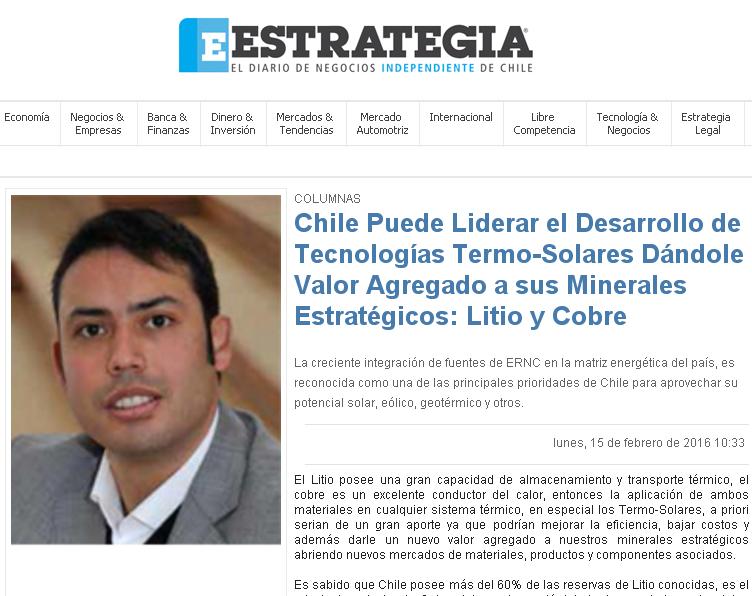
In his column of February 15 in Diario Estrategia, the academician and Director of the MCI on Energy and Environment UAI highlighted the contribution of SERC in the development of solar energy at a national level.
Read the column:
Chile Can Lead the Development of Thermo-Solar Technologies by Adding Value to Strategic Minerals such as Lithium and Copper.
The growing integration of NCRE sources within the country’s energy matrix is recognized as one of Chile’s top priorities for harnessing its solar, wind, geothermal and other powers.
Monday, February 15, 2016 10:33
Lithium has a large storage and thermal transport capacity, and copper is an excellent conductor of heat, so the application of both materials in any thermal system, especially thermo-solar systems, would a priori be a great contribution as they could improve efficiency, lower costs and also give added value to our strategic minerals by opening new markets for materials, products and other components.
It is known that Chile owns more than 60% of the known Lithium reserves and is the main producer of Copper of the world, endowed with one of the highest potentials of solar energy of the planet. Regarding materials, our country has declared Lithium and copper as strategic minerals because of their obvious importance to the national economy, contributing with approximately 10% of our GDP according to figures from the Mining Council. In spite of these encouraging data, our country must give priority to sustainable developments so as not to depend exclusively on market variations. Sustainable development requires the transformation of resources into other forms of wealth, such as buildings, machines, new materials and human capital. Following this sustainable approach, certain assessments can be made to ascertain whether it is technically and economically viable to transform the country’s copper and lithium reserves into competitive energy produced in the same region where these metals are obtained, favoring local communities and the region in general.
The growing integration of non-conventional renewable energy (NCRE) sources into the country’s energy matrix is recognized as one of Chile’s top priorities for harnessing its solar, wind, geothermal and other powers. The Paris Summit on climate (COP 21) has highlighted the important role that renewable energy will play in the world’s energy future and, in the particular case of Chile, it has been established that solar energy will lead its development, creating important initiatives such as the “Strategic Solar Program” of CIFES-CORFO (http://cifes.gob.cl/programas/programa-estrategico-solar/), the “Solar Energy Research Center” (SERC-Chile, www.sercchile.cl) of CONICYT, and supporting the implementation of some centers of excellence such as Fraunhofer and Laborelec.
One of the biggest and most important problems of these national initiatives for all countries is the intermittent nature of solar energy, which makes it difficult to match supply with energy demands. In particular for solar concentrator plants (CSP, for its Spanish acronym), Thermal Energy Storage (TES) is considered a key alternative that allows plants to operate when no solar radiation is available, increasing the plant capacity factor from 20% to 25% without the TES system, and from 40% to 50% with 6 – 7.5 hours of TES system. In fact, Chile is preparing to host a new solar thermal power plant with a capacity of 110 MW, which will have an advanced storage system to operate with a capacity factor of 80% and generate electricity for up to 17.5 hours without sun. The main TES material in CSP plants used by some technologies and by Heat Transfer Fluid (HTF) is liquid or molten salt, composed of 60% NaNO3 and 40% KNO3 also known as “solar salt”, which is kept warm with temperatures above its melting point 223 °C, and for which Chile is the top world producer. It should be noted that TES and HTF materials can always be improved and significant research efforts are already under way in the world to develop new and more efficient materials to reduce costs. First, the development of new materials with lower melting points as TES and HTF is a key challenge, as they will avoid, for example, blockages caused by solidification in pipes below the melting temperature, energy self-consumption expenses and other costs in CAPEX and OPEX. In this context, there are recent preliminary studies on thermal materials for CSP (http://www.mdpi.com/2071-1050/8/2/106/htm), such as those made by researchers Macarena Montané, Shahriyar Nasirov and Raúl O’Ryan from Universidad Adolfo Ibáñez (UAI), which show that salt mixtures with lithium nitrate may be a potential alternative to solve the risk of solidification of solar salt in double tank TES systems, thus reducing energy costs (LCOE) by up to 4% and improving system efficiency due to the high energy power of Lithium.
On the other hand, since materials with higher energy densities reduce the required amount of storage material, latent heat storage with PCMs between solid-liquid has also been identified as a possible alternative to improve TES systems.
These PCMs have a low thermal conductivity, which causes a decrease in the rate of heat transfer and the efficiency of energy use. In particular, copper, given its high thermal conductivity, is considered to be one of the most suitable and promising materials for heat transfer. Some studies where, for example, copper sponges [1] and PCM encapsulated in copper [2] would be a good solution have already been carried out, but their manufacturing costs still need to be lowered in order to make it an economically viable option.
In conclusion, Lithium and Copper are very promising materials. We are on the right path to achieve a remarkable development in the thermal and solar industry, but to succeed, we must never abandon the support and interest for innovation.
Gustavo Cáceres, MCI Director in Energy and Environment UAI.


